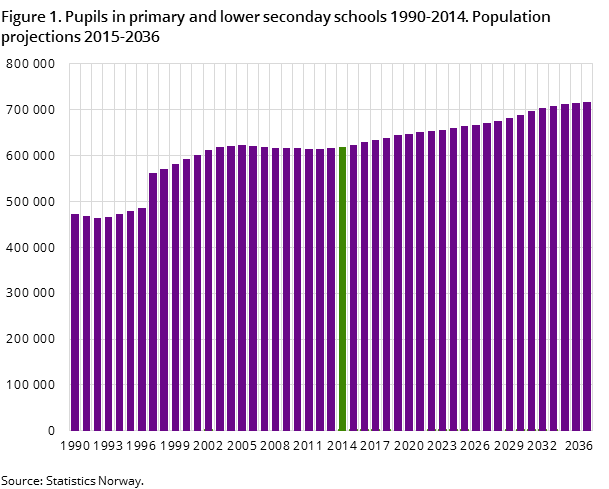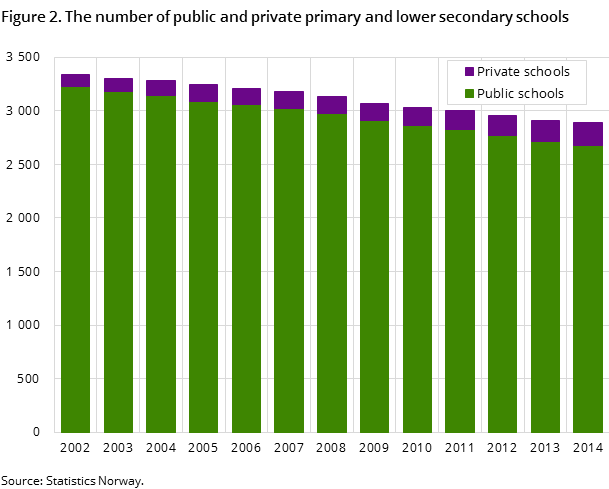Content
Published:
This is an archived release.
Fewer pupils receiving special education
Since 2011, there has been a decrease of 3 300 pupils who receive special education. In total, 8 per cent of pupils are receiving special education in 2014.
| 2014 | Per cent change | Per cent change | |
|---|---|---|---|
| 2013 - 2014 | 2004 - 2014 | ||
| Primary and lower secondary schools, total | 2 886 | -0.7 | -12.0 |
| Private schools | 208 | 6.7 | 48.6 |
| Public schools | 2 678 | -1.0 | -14.9 |
| Pupils, total | 618 996 | 0.6 | -0.3 |
| Pupils in private schools | 20 436 | 7.0 | 58.5 |
| Pupils in public schools | 598 560 | 0.4 | -1.5 |


As in previous years, the number of pupils who receive special education increased according to year, where 3.6 per cent of first graders and 11 per cent of 10th graders receive special education. The majority of the pupils who receive special education - 70 per cent - are boys.
Steady increase in pupils
The number of pupils does not change much from one year to another but has increased for a number of years, and is expected to continue to increase. As of 1 October 2014, there were almost 619 000 pupils in primary and lower secondary schools, which is an increase of 3 000 pupils from 2013. Based on population projections, the number of pupils is expected to increase by 100 000 in 20 years time.
Fewer schools in total, but more private schools
While the number of primary and lower secondary schools is decreasing, the number of private schools is increasing. There are about 100 more private schools than in 2002, while the number of public schools has fallen by 545. Today, 7.2 per cent of all the primary and lower secondary schools are private, with and without state subsidies. The counties with the highest number of private schools are Rogaland, Hordaland and Møre og Romsdal, while Oslo and Hordaland have the most pupils attending private schools.
The number of pupils in primary and lower secondary schools is also increasing in line with the number of schools. On the other hand, the total share of pupils in private schools is only 3 per cent, which is a relatively low share compared with other countries. In Denmark for instance, 15 per cent of pupils at primary level and 27 per cent of pupils at lower secondary level attend private schools. The OECD average shows that 11 per cent of pupils at primary level and 15 per cent of pupils at lower secondary level attend private schools.
Minority language pupils in primary and lower secondary schools
In total, 7 per cent of pupils receive additional training in Norwegian, and the number of pupils has not changed particularly in recent years. Since 2013, there has been a reduction of 1 900 pupils receiving native language training and/or bilingual education or adapted education. The native languages that are used the most in these forms of education/training are Polish, Somali and Arabic.
One third of the teachers are aged 50 or older
KOSTRA figures for the fiscal year 2013 show that 33 per cent of primary and lower secondary school teachers are aged 50 or older, while 25 per cent are in their 40s. The teacher age distribution for the OECD average was about the same in 2012. At the same time, several OECD countries have a higher share of teachers who are 50 or older than Norway. Sixty-two per cent of the Italian lower secondary school teachers, for instance, are 50 or older. On the other hand, the United Kingdom has the largest share of teachers in primary schools under the age of 30; 31 per cent compared with 13 per cent in Norway.
On average across OECD countries, 82 per cent of teachers at primary level and 67 per cent of teachers at lower secondary level are women. In comparison, 75 per cent of Norwegian primary and lower secondary teachers are women. Of all the OECD countries, Turkey has the highest share of male teachers at primary level, with 45 per cent, while Japan is the only country with a higher share of men than women teachers at lower secondary level.
KOSTRAOpen and readClose
KOSTRA (Municipality-State-Reporting) is a national information system that provides information on municipal and county municipal activities. Statbank gives key figures related to primary and lower secondary schools, such as net operating expenditures per capita, out of school care, wage expenditures per pupil, average group sizes etc.
Contact
-
Emmie Stolpe Foss
E-mail: emmie.foss@ssb.no
tel.: (+47) 40 81 14 30
-
Per Torstein Tuhus
E-mail: per.torstein.tuhus@ssb.no
tel.: (+47) 40 81 13 49
